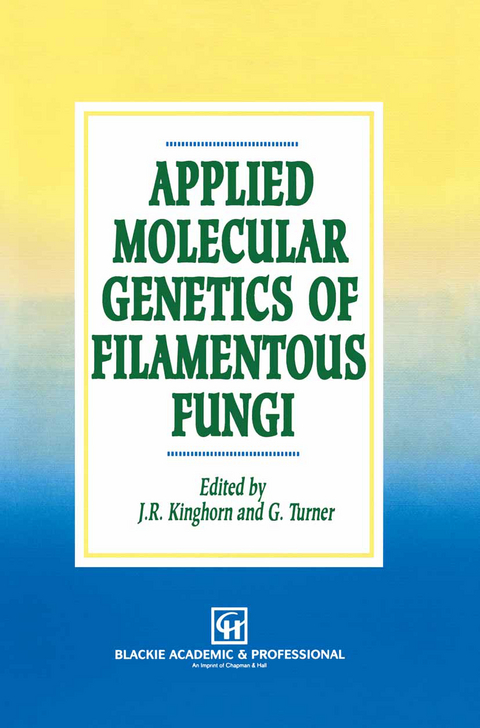
Applied Molecular Genetics of Filamentous Fungi
Chapman and Hall (Verlag)
978-0-7514-0058-8 (ISBN)
The filamentous fungi are perhaps unique in the diversity of their metabolic activities. This includes biosynthetic as well as degradative activities, many is to provide an of which are of industrial interest. The objective of this text up-to-date and broad review which emphasizes the genetic and molecular biological contribution in the field of fungal biotechnology. This text begins with an overview of the tools and methodologies involved which, to a large extent, have been developed in the model filamentous fungus Aspergillus nidulans and subsequently have been extended to commercially important fungi. This is followed by a chapter which provides a compilation of genes isolated from commercial fungi and their present status with respect to structure, function and regulation. Chapters 3 and 4 highlight the degradative powers of filamentous fungi. First, a discussion of what is known regarding the molecular genetics of fungi and the genes and enzymes involved in the beverage and food industries. This has an oriental flavour, reflecting the tremendous importance of fungi in traditional Chinese and Japanese food production. An account of lignocellulose degradation by filamentous fungi follows, illustrating the potential of fungi to utilize this substance as a renewable energy source. The ability of fungi to produce high-value foreign proteins is reviewed in chapters 5 and 6. Chymosin production, in particular, represents a good example of high-level yields being obtained, such as to warrant commercial production.
1 Fungal technology.- 1.1 Introduction.- 1.2 Selective markers.- 1.3 Transformation procedures.- 1.4 Fate of transforming DNA in Aspergillus nidulans.- 1.5 Expression vectors.- 1.6 Karyotyping.- 1.7 Restriction fragment length polymorphism mapping.- References.- 2 Gene organization in industrial filamentous fungi.- 2.1 Introduction.- 2.2 Gene structure.- 2.3 Gene regulation.- 2.4 Prospects.- References.- 3 Fungal enzymes used in oriental food and beverage industries.- 3.1 Introduction.- 3.2 Fungal industries in Japan.- 3.3 Fungal industries in China.- 3.4 Modern industries based on fungal enzymes.- 3.5 Genetic transformation systems for Rhizopus.- 3.6 Proteolytic enzymes.- 3.7 Pectinolytic enzymes and RNases.- 3.8 Lipases.- 3.9 Fungal enzymes used in starch processing.- 3.10 Summary.- References.- 4 Fungal enzymes for lignocellulose degradation.- 4.1 Introduction.- 4.2 Cellulose degradation.- 4.3 Hemicellulose degradation.- 4.4 Lignin degradation.- 4.5 Applications.- References.- 5 Foreign proteins.- 5.1 Introduction.- 5.2 Industrial enzymes and food products.- 5.3 Proteins of pharmaceutical interest.- 5.4 Expression of other proteins.- 5.5 Scale-up, production and regulatory aspects.- 5.6 Future prospects.- References.- 6 Stability of recombinant strains under fermentation conditions.- 6.1 Introduction.- 6.2 Fermentation.- 6.3 Isolation and stability of chymosin-producing strains.- 6.4 Regulatory issues.- 6.5 Preservation of recombinant fungal strains.- 6.6 Conclusions.- References.- 7 Molecular biology of filamentous fungi used for biological control.- 7.1 Introduction.- 7.2 Mechanisms of biological control activity.- 7.3 Strain improvement.- 7.4 Molecular markers for the characterization of biocontrol fungi.- References.- 8 The application of biotechnology to the button mushroom, Agaricus bisporus.- 8.1 Introduction.- 8.2 Biological barriers to mushroom strain development.- 8.3 Systematic isolation and verification of homokaryons.- 8.4 Production and verification of new mushroom strains.- 8.5 A genetic linkage map and karyotype analysis for the button mushroom.- 8.6 Molecular genetic studies on the mitochondria of Agaricus.- 8.7 Extrachromosomal elements in Agaricus.- 8.8 Conclusions.- References.- 9 The application of molecular genetics to oriental mushrooms.- 9.1 Introduction.- 9.2 Description of oriental edible fungi.- 9.3 Studies of the molecular biology and biochemistry of oriental mushrooms.- 9.4 Future prospects.- References.- 10 Secondary metabolites.- 10.1 Introduction.- 10.2 Fungal secondary metabolites.- 10.3 Are most genes for secondary metabolites tightly linked to each other?.- 10.4 Hybrid secondary metabolites: strains producing metabolites which are not formed in nature.- References.- 11 Future prospects.
The editors have achieved much in bringing together a wide range of material in such an accessible form.TIBTech
| Erscheint lt. Verlag | 31.8.1992 |
|---|---|
| Zusatzinfo | XII, 259 p. |
| Verlagsort | London |
| Sprache | englisch |
| Maße | 155 x 235 mm |
| Themenwelt | Studium ► 2. Studienabschnitt (Klinik) ► Humangenetik |
| Naturwissenschaften ► Biologie ► Genetik / Molekularbiologie | |
| Naturwissenschaften ► Biologie ► Mykologie | |
| Naturwissenschaften ► Biologie ► Zoologie | |
| ISBN-10 | 0-7514-0058-0 / 0751400580 |
| ISBN-13 | 978-0-7514-0058-8 / 9780751400588 |
| Zustand | Neuware |
| Haben Sie eine Frage zum Produkt? |
aus dem Bereich


